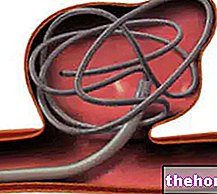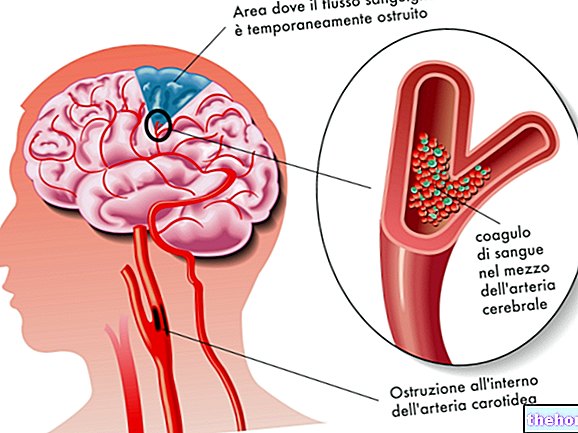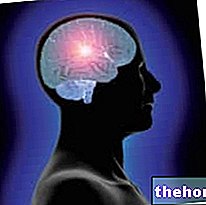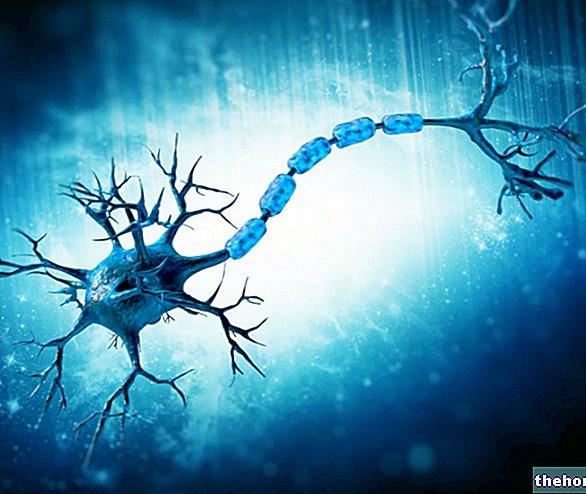Diagnosis
The rupture of a brain aneurysm causes immediate and somewhat unambiguous effects.
Therefore, already from the description of the symptoms suffered by the patient, the doctor is able to establish a pre-diagnosis.

Figure: a "diagnostic image of a brain aneurysm. From the site: www.fundaceclm.org
Clearly, further diagnostic investigations are needed, which provide more information on the location and severity of the aneurysm.
During the diagnosis, it is essential to proceed with maximum speed and accuracy, since the condition of the patient, affected by a cerebral aneurysm, is critical.
OBJECTIVE EXAMINATION
During the physical examination, the doctor questions the patient, or whoever was with him at the time of the onset of symptoms, to understand if it can actually be a brain aneurysm. In these situations, therefore, the description of the symptoms and lifestyle habits it becomes the first true source of information (anamnesis).
Headache, confusion, visual difficulties, wrong eating habits, chronic hypertension, etc., are all elements which, if present, lead to think of a possible aneurysm and a cerebral hemorrhage.
The physical examination also becomes very important when you come across a patient who complains of symptoms of an unruptured brain aneurysm.
INSTRUMENTAL DIAGNOSTICS
The instrumental tests allow to confirm or exclude the pre-diagnosis, the site of the aneurysm and the area of the brain affected. Knowing these details helps the doctor to intervene immediately on the patient.
In addition, certain diagnostic tests also allow to recognize cerebral aneurysms that are not ruptured or characterized by small blood losses.
- Computed Axial Tomography (CT). It is an X-ray examination, which provides fairly clear images of the brain. It shows if there has been a rupture of an aneurysm and where it occurred (CT angiography). This is usually the first exam the patient undergoes. It is considered mildly invasive, as it uses ionizing radiation .
- Lumbar puncture. It consists in the sampling of the cerebrospinal fluid (or liquor) and in its analysis. When a subarachnoid hemorrhage occurs, the patient's CSF contains traces of blood. For its possible side effects, lumbar puncture is performed only if the CT scan has given a negative result, but the presence of an aneurysm remains the most accredited hypothesis. .
- Nuclear magnetic resonance (NMR). Provides clear images of the blood vessels and the rupture site. In addition, it is the most widely applied test in cases of unruptured brain aneurysms, as it does not use harmful ionizing radiation.
- Cerebral angiography. After inserting a catheter and contrast fluid into a patient's main arterial system, you can see (on X-rays) what the blood flow is like within the vessels supplying the brain.
THE SCREENING OF SYMPTOM-FREE ANEURISMS
It is not common to subject individuals to instrumental tests for the search for aneurysms not yet manifest. It is the doctor himself who advises against any diagnostic test, especially those of an invasive type.
However, there are exceptions: if there is "a family history of brain aneurysm or if there" is one of the aforementioned congenital diseases associated with aneurysms, your doctor may suggest that you undergo these tests.
Treatment
When a brain aneurysm ruptures, the situation is critical and the patient requires immediate medical attention and surgery.
The same care, given to these individuals, can also be reserved for those who have aneurysms close to rupture. However, in these situations, the situation must be assessed on a case-by-case basis: if the risk of haemorrhage is high then action is taken, otherwise it is limited to periodic observation and control of symptoms and predisposing situations.
THE SURGERY
Two types of surgery can be used to treat a ruptured brain aneurysm:
- Operation of clipping (or clipping). The surgeon, first, cuts and removes part of the skull (craniotomy), to access the area presided over by the aneurysm. Then, he applies a sort of clamp (clip) at the neck of the aneurysm, with the aim of preventing the blood from flowing again and thus breaking the vessel wall for the second time.

Figure: a "diagnostic image of a brain aneurysm. From the site: www.fundaceclm.org Therefore, with this procedure, the aneurysm is sealed from the outside.
Pro: allows you to repair the blood vessels that have broken.
Against: considerable invasiveness, risk of complications during surgery and very long hospitalization. - Operation of coiling endovascular (or aneurysm closure). Unlike clipping, this is a technique that resolves the aneurysm from the inside. In fact, the surgeon inserts a small catheter in the groin and transports it to where the aneurysm is. catheter is equipped with one or more platinum spirals, which are positioned inside the aneurysm to occlude it. This sort of tamponade allows the elements of the coagulation system to occlude the opening of the aneurysm, so that the blood can circulate, without accessing it anymore.
Pro: less invasive, less risky and shorter hospitalization.
Against: one in 5 cases requires a second intervention.
The choice of the most suitable surgical procedure
Size, shape and location of the aneurysm are the three factors on which the surgeon relies before choosing the most appropriate procedure.
Besides these evaluations, there are, then, the pros and cons linked to each type of intervention.
The right considerations on these parameters are fundamental, but they don't have to be the only ones. In fact, it is equally important to remember that a cerebral aneurysm is an emergency situation to be treated quickly and promptly. The surgeon, very often, not having the time to think about the risks and benefits of a specific operative choice, must rely on his own experience.
UNBREAKED ANEURISMS: HOW AND WHEN TO ACT
If after a thorough diagnosis it is found that the rupture of an aneurysm that is still intact is highly probable, surgery is opted for. the state of the aneurysm.
The judgment, in these cases, is up to the surgeon, who considers the following parameters:
- Age of the patient. For an elderly patient, surgery hides more pitfalls than living with an unruptured aneurysm.
- Size of the aneurysm. We usually intervene on aneurysms of 7 millimeters or more. For the smaller ones, it is necessary to evaluate the site, the family history and the state of health of the patient.
- Location of the aneurysm. The risk of a rupture is greater if the aneurysm is in larger vessels, because the blood flow is more turbulent.
- Family history of a ruptured aneurysm.
- State of health of the patient and presence of one or more risk factors for aneurysm. Risk factors (hypertension, congenital diseases, etc.) must be evaluated.
MEDICAL ASSISTANCE: OTHER TREATMENTS
A patient who has suffered a rupture of an aneurysm, in addition to requiring surgery, also needs other treatments that remedy the consequences of the bleeding and restore normal brain activity. Without them, one of the main consequences in which there is you may come across is cerebral ischemia (or ischemic stroke).
The following table summarizes the main pharmacological / clinical treatments, put into practice in case of rupture of a cerebral aneurysm.
Non-surgical treatments:
- Analgesic drugs, against pain
- Calcium antagonist drugs, against vasospasm
- Antihypertensive drugs and vasopressor agents, against vasospasm
- Antiepileptics
- CSF drainage, against hydrocephalus
- Rehabilitation, to restore motor and language functions
Prognosis and prevention
The prognosis for a brain aneurysm depends on several factors and varies from patient to patient.
When the rupture of the aneurysm occurs, the patient is in critical health and needs immediate care. Without prompt intervention, the patient dies. If help (for whatever reason) is not timely, the probability of dying is or at least to suffer serious consequences, it is high.On the other hand, the statistical data, relating to the percentage of death due to rupture of a cerebral aneurysm, speak for themselves: 20-30% of patients die before reaching the hospital; while 50% die after 30 days.
A special discussion, on the other hand, must be made for non-ruptured aneurysms: in these cases, the prognosis depends on the "entity" of the aneurysm and on the need or not to operate. However, it should not be forgotten that, in these cases, a lot also depends on the patient and on the attention that he will devote to his health (periodic checks and reduction of risk factors).
PREVENTION
As with all diseases, the prevention of risk factors is essential, especially when you are aware of being predisposed to a brain aneurysm, stroke, etc.
In these situations, the most important advice that can be given is to adopt a healthy lifestyle, so do not smoke, do not abuse alcohol, do not take drugs, eat healthy, practice even moderate physical activity.
While it may be vital to follow these guidelines before a brain aneurysm appears, it is vital afterwards.





























